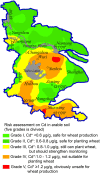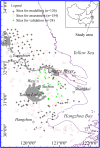Ecological risk assessment on heavy metals in soils: Use of soil diffuse reflectance mid-infrared Fourier-transform spectroscopy
- PMID: 28198802
- PMCID: PMC5304163
- DOI: 10.1038/srep40709
Ecological risk assessment on heavy metals in soils: Use of soil diffuse reflectance mid-infrared Fourier-transform spectroscopy
Abstract
The bioavailability of heavy metals in soil is controlled by their concentrations and soil properties. Diffuse reflectance mid-infrared Fourier-transform spectroscopy (DRIFTS) is capable of detecting specific organic and inorganic bonds in metal complexes and minerals and therefore, has been employed to predict soil composition and heavy metal contents. The present study explored the potential of DRIFTS for estimating soil heavy metal bioavailability. Soil and corresponding wheat grain samples from the Yangtze River Delta region were analyzed by DRIFTS and chemical methods. Statistical regression analyses were conducted to correlate the soil spectral information to the concentrations of Cd, Cr, Cu, Zn, Pb, Ni, Hg and Fe in wheat grains. The principal components in the spectra influencing soil heavy metal bioavailability were identified and used in prediction model construction. The established soil DRIFTS-based prediction models were applied to estimate the heavy metal concentrations in wheat grains in the mid-Yangtze River Delta area. The predicted heavy metal concentrations of wheat grain were highly consistent with the measured levels by chemical analysis, showing a significant correlation (r2 > 0.72) with acceptable root mean square error RMSE. In conclusion, DRIFTS is a promising technique for assessing the bioavailability of soil heavy metals and related ecological risk.
Conflict of interest statement
The authors declare no competing financial interests.
Figures






Similar articles
-
Heavy metal contents, distribution, and prediction in a regional soil-wheat system.Sci Total Environ. 2016 Feb 15;544:422-31. doi: 10.1016/j.scitotenv.2015.11.105. Epub 2015 Dec 4. Sci Total Environ. 2016. PMID: 26657387
-
Concentration estimation of heavy metal in soils from typical sewage irrigation area of Shandong Province, China using reflectance spectroscopy.Environ Sci Pollut Res Int. 2017 Jul;24(20):16883-16892. doi: 10.1007/s11356-017-9224-x. Epub 2017 Jun 1. Environ Sci Pollut Res Int. 2017. PMID: 28573565
-
Assessment of the bioavailability, bioaccessibility and transfer of heavy metals in the soil-grain-human systems near a mining and smelting area in NW China.Sci Total Environ. 2017 Dec 31;609:822-829. doi: 10.1016/j.scitotenv.2017.07.215. Epub 2017 Jul 30. Sci Total Environ. 2017. PMID: 28768215
-
Accumulation of heavy metals in soil-crop systems: a review for wheat and corn.Environ Sci Pollut Res Int. 2017 Jun;24(18):15209-15225. doi: 10.1007/s11356-017-8909-5. Epub 2017 Apr 29. Environ Sci Pollut Res Int. 2017. PMID: 28455572 Review.
-
Measurement of soil lead bioavailability and influence of soil types and properties: A review.Chemosphere. 2017 Oct;184:27-42. doi: 10.1016/j.chemosphere.2017.05.143. Epub 2017 May 24. Chemosphere. 2017. PMID: 28578193 Review.
Cited by
-
New Prospects in the Electroanalysis of Heavy Metal Ions (Cd, Pb, Zn, Cu): Development and Application of Novel Electrode Surfaces.Methods Protoc. 2023 Jun 26;6(4):60. doi: 10.3390/mps6040060. Methods Protoc. 2023. PMID: 37489427 Free PMC article. Review.
-
Estimating the Heavy Metal Contents in Entisols from a Mining Area Based on Improved Spectral Indices and Catboost.Sensors (Basel). 2024 Feb 25;24(5):1492. doi: 10.3390/s24051492. Sensors (Basel). 2024. PMID: 38475028 Free PMC article.
-
Sources and level of heavy metal contamination in the water of Awetu watershed streams, southwestern Ethiopia.Heliyon. 2021 Mar 24;7(3):e06385. doi: 10.1016/j.heliyon.2021.e06385. eCollection 2021 Mar. Heliyon. 2021. PMID: 33855229 Free PMC article.
-
Soil heavy metal contamination assessment in the Hun-Taizi River watershed, China.Sci Rep. 2020 May 26;10(1):8730. doi: 10.1038/s41598-020-65809-0. Sci Rep. 2020. PMID: 32457428 Free PMC article.
-
Inhibition of microbially mediated total organic carbon decomposition in different types of cadmium contaminated soils with wheat straw addition.Sci Rep. 2024 Jul 2;14(1):15114. doi: 10.1038/s41598-024-64267-2. Sci Rep. 2024. PMID: 38956155 Free PMC article.
References
-
- Kabata-Pendias A. Soil–plant transfer of trace elements—an environmental issue. Geoderma 122, 143–149 (2004).
-
- Davis A., Ruby M. V. & Bergstrom P. D. Factors controlling lead bioavailability in the Butte mining district, Montana, USA. Environ. Geochem. Health 3(4), 147–157 (1994). - PubMed
-
- Violante A., Cozzolino V., Perelomov L., Caporale A. G. & Pigna M. Mobility and bioavailability of heavy metals and metalloids in soil environments. J. Soil. Sci. Plant Nutr. 10(3), 268–292 (2010).
-
- Roberts D., Scherrer P. & Sparks D. L. Speciation of metals in soils. In Chemical Processes in Soils–SSSA Book Series No. 8 (eds Tabatabai M. A. & Sparks D. L.), 619–654 (Soil Science Society of America: Madison, Wisconsin, USA, 2005).
Publication types
MeSH terms
Substances
LinkOut - more resources
Full Text Sources
Other Literature Sources

